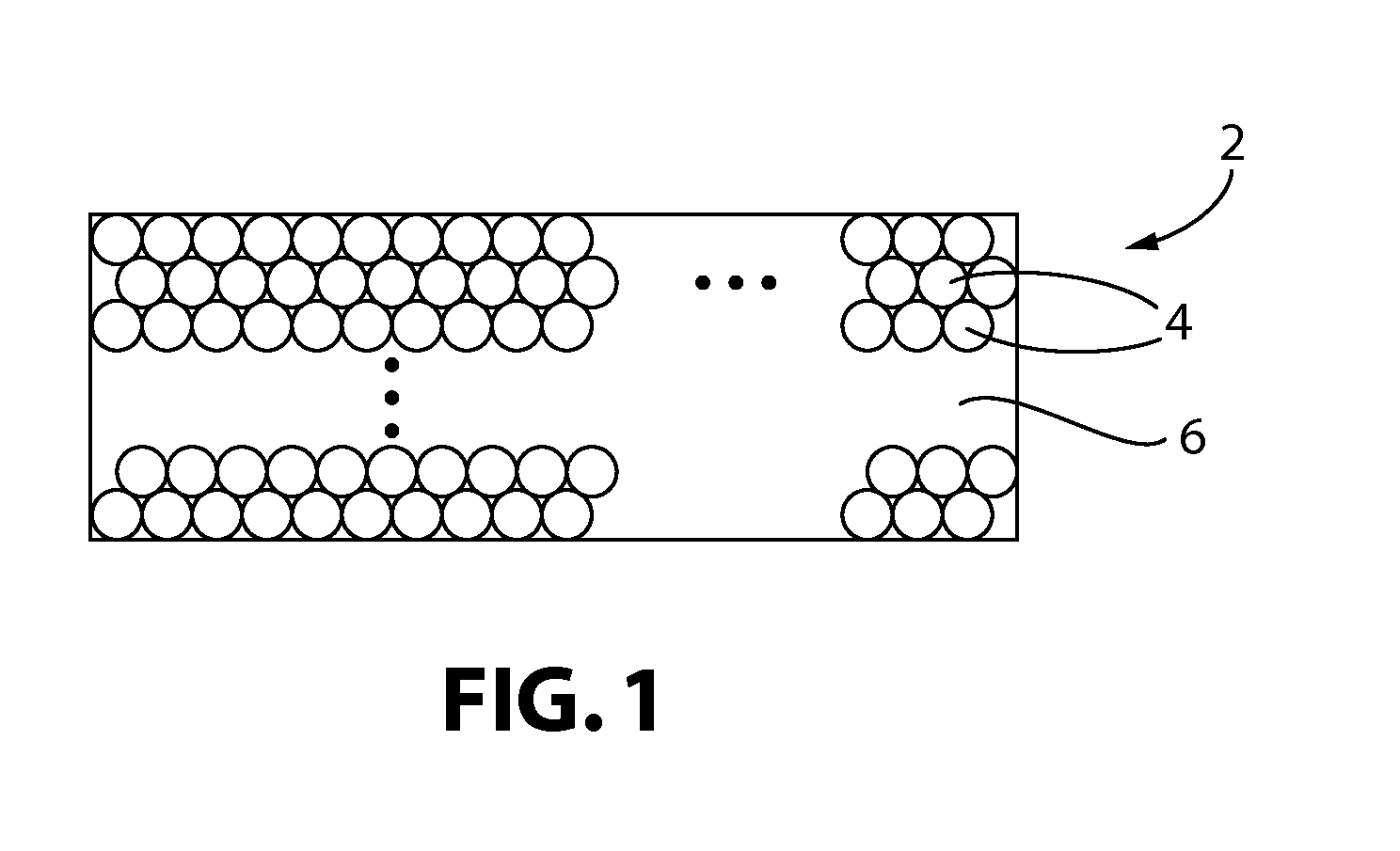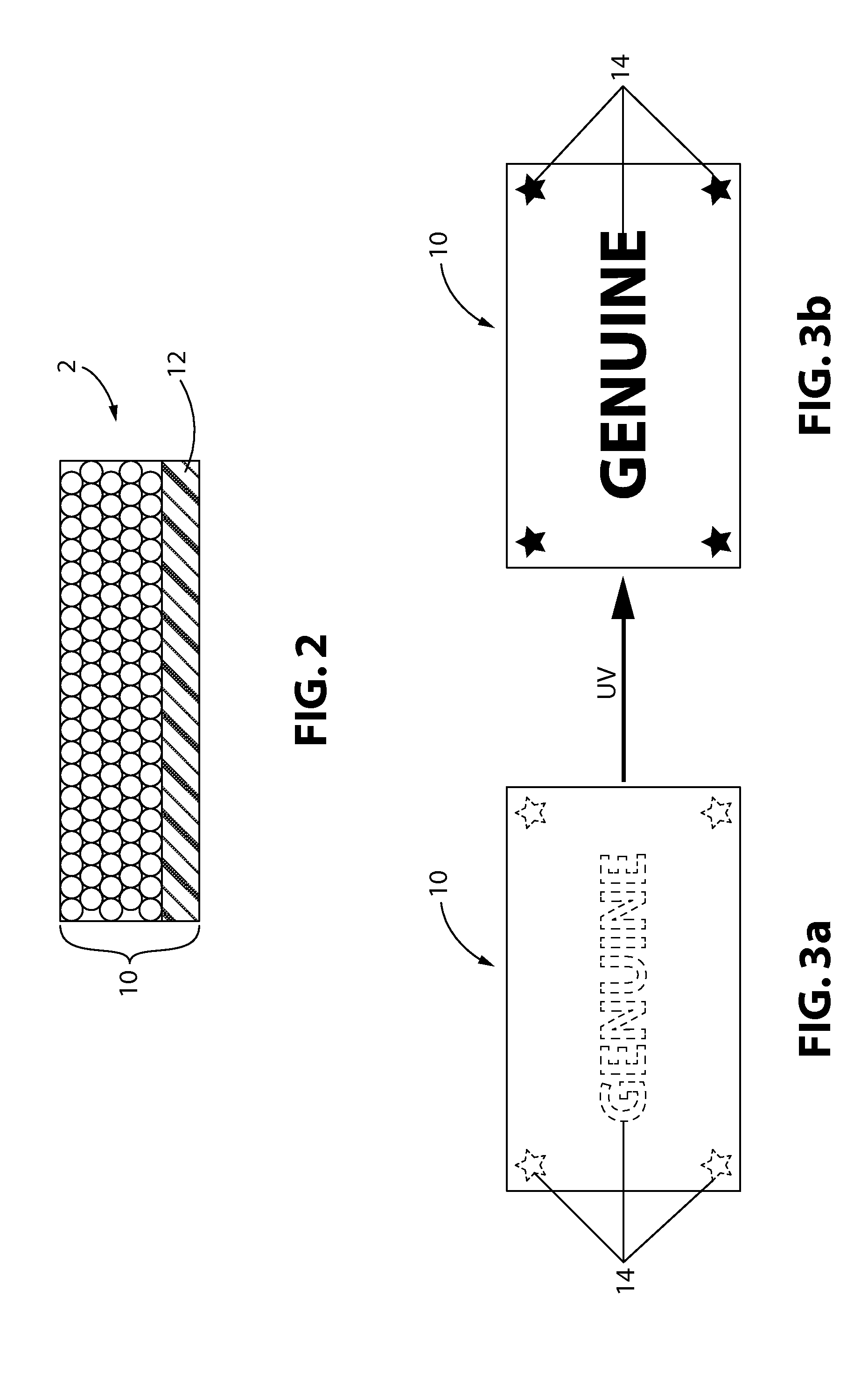Composite crystal colloidal array with photochromic member
a colloidal array and composite material technology, applied in the field of composite materials, can solve the problems of relatively limited use of radiation diffracting materials in security devices
- Summary
- Abstract
- Description
- Claims
- Application Information
AI Technical Summary
Benefits of technology
Problems solved by technology
Method used
Image
Examples
example 1
Step 1: UV Curable Organic Matrix
[0161]An ultraviolet radiation curable organic composition was prepared via the following procedure. Diphenyl(2,4,6-trimethylbenzoyl) phosphineoxide / 2-hydroxy-2-methyl-propiophenone (0.25 g), 50 / 50 blend from Aldrich Chemical Company, Inc., Milwaukee, Wis., was added with stirring to a mixture of 6 g ethoxylated (20) trimethylol propane triacrylate and 3.5 g of propoxylated neopentyl glycol diacrylate, and 0.5 g of pentaerythritol tetraacrylate, all from Sartomer Company, Inc., Exton, Pa.
Step 2: Color-Shifting, Imaged Crystalline Colloidal Array Film
[0162]A crystalline colloidal array (CCA) film without the interstitial spaces filled was prepared in the same manner as described in U.S. Pat. No. 7,682,530 on a polyethylene terephthalate (PET) support film. Material from Step 1 of Example 1 was applied to this film to fill the interstitial spaces. A PET coversheet was applied over the film and UV radiation curable coating was then rolled to spread the ...
example 2
Step 1: UV Radiation Curable Organic Matrix Containing Photochromic Dye
[0165]A gray photochromic dye composition was prepared using the crystalline organic dyes PPG Photosol® 0265, PPG Photosol® 5-3, PPG Photosol® 7-106, commercially available from PPG Industries, Inc., Pittsburgh, Pa. The dyes were each added at 0.33 g to 3 g of methyl ethyl ketone to make a homogeneous mixture. The solvent and dye mixture was added to 6 g of the UV radiation curable organic composition from Example 1 in an open container. The container was placed in a 200° F. oven for approximately 1 hour to evaporate the 3 g methyl ethyl ketone. A material balance was used to determine the elimination of methyl ethyl ketone.
Step 2: Color-Shifting, Imaged Crystalline Colloidal Array Film Containing Photochromic Dye
[0166]A CCA film without the interstitial spaces filled was prepared in the same manner as described in U.S. Pat. No. 7,682,530 on a PET support film. Material from Step 1 of Example 2 was applied to thi...
example 3
Step 1: Color-Shifting, Imaged Crystalline Colloidal Array Film on a Support
[0169]A CCA film without the interstitial spaces filled was prepared in the same manner as described in U.S. Pat. No. 7,682,530 on a PET support film. Material from Step 1 of Example 1 was applied to this film to fill the interstitial spaces. A PET coversheet was applied over the film and UV radiation curable coating and was then rolled to spread the UV radiation curable coating to a uniform thickness. The film was heated in a 215° F. oven until a color change was observed when looking at the film from a normal angle (green to orange reflectance), then placed on an opacity chart (byko-chart, BYK-Gardner USA) with the PET coversheet facing the black background. An image of a simple shape was printed with an ink jet printer onto a transparency to create a mask. The mask was placed on the backside of the PET substrate supporting the CCA film and the assembly was exposed to UV radiation. The mask was removed and...
PUM
 Login to View More
Login to View More Abstract
Description
Claims
Application Information
 Login to View More
Login to View More - R&D
- Intellectual Property
- Life Sciences
- Materials
- Tech Scout
- Unparalleled Data Quality
- Higher Quality Content
- 60% Fewer Hallucinations
Browse by: Latest US Patents, China's latest patents, Technical Efficacy Thesaurus, Application Domain, Technology Topic, Popular Technical Reports.
© 2025 PatSnap. All rights reserved.Legal|Privacy policy|Modern Slavery Act Transparency Statement|Sitemap|About US| Contact US: help@patsnap.com



